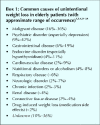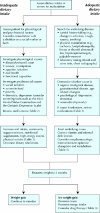An approach to the management of unintentional weight loss in elderly people
- PMID: 15767612
- PMCID: PMC552892
- DOI: 10.1503/cmaj.1031527
An approach to the management of unintentional weight loss in elderly people
Abstract
Unintentional weight loss, or the involuntary decline in total body weight over time, is common among elderly people who live at home. Weight loss in elderly people can have a deleterious effect on the ability to function and on quality of life and is associated with an increase in mortality over a 12-month period. A variety of physical, psychological and social conditions, along with age-related changes, can lead to weight loss, but there may be no identifiable cause in up to one-quarter of patients. We review the incidence and prevalence of weight loss in elderly patients, its impact on morbidity and mortality, the common causes of unintentional weight loss and a clinical approach to diagnosis. Screening tools to detect malnutrition are highlighted, and nonpharmacologic and pharmacologic strategies to minimize or reverse weight loss in older adults are discussed.
Figures
References
-
- Marton KI, Sox HC, Jr., Krupp JR. Involuntary weight loss: diagnostic and prognostic significance. Ann Intern Med 1981;95(5):568-74. - PubMed
-
- Payette H, Coulombe C, Boutier V, Gray-Donald K. Nutrition risk factors for institutionalization in a free-living functionally dependent elderly population. J Clin Epidemiol 2000;53(6):579-87. - PubMed
-
- Rabinovitz M, Pitlik SD, Leifer M, Garty M, Rosenfeld JB. Unintentional weight loss. A retrospective analysis of 154 cases. Arch Intern Med 1986;146(1):186-7. - PubMed
-
- Bilbao-Garay J, Barba R, Losa-Garcia JE, Martin H, Garcia de Casasola G, Castilla V. Assessing clinical probability of organic disease in patients with involuntary weight loss: a simple score. Eur J Intern Med 2002;13(4):240-5. - PubMed
-
- Payette H, Coulombe C, Boutier V, Gray-Donald K. Weight loss and mortality among free-living frail elders: a prospective study. J Gerontol A Biol Sci Med Sci 1999;54(9):M440-5. - PubMed



